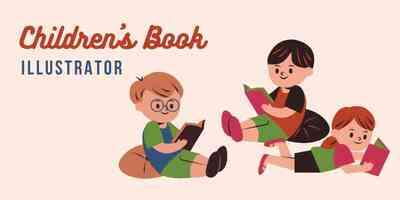8 Useful Illustration Tips for Beginners
How to become a book cover illustrator
As an illustrator, there are many career pathways you can choose from. One of these is a book cover artist. Promoting new book titles in the digital age relies heavily on social media platforms, making cover art integral to its success. Books, like never before, are literally being judged by their covers, making the time ripe to choose cover illustration as a career!

Three steps to help you get a job as a book cover illustrator
But, how do I get hired to design a book cover? We chatted with CG Spectrum mentor, award-winning illustrator, and book cover artist Eric Wilkerson about how to make a start in the industry.
What does a book cover artist do?
A book cover artist is responsible for distilling the story, theme, and tone of a book (novels, graphic novels, children’s books, textbooks, etc.) into a cover illustration comprised of imagery and text. The artwork assists the author and publishing house in capturing the attention of its target readership.
Like most creative careers, the line you draw to get there is often far from straightforward. However, there are some practical steps you can take to help you land your first gig as a book cover artist:
Build a strong portfolio Start networking Remove self-doubt
Let’s dive into these steps in more detail.
Iconic book covers are instantly recognizable. (Credit: Bloomsbury)
Step 1 - Build a strong portfolio
A solid portfolio will help lay down the foundations on which you can start building your career, including what kinds of places will hire you and what types of projects you’ll be offered. Your portfolio should showcase your best work while also focusing on the variety of art you want to pursue.
Eric says it’s also vital to make art you enjoy. A lack of passion will permeate your portfolio and could mean the difference between getting your dream job or not.
One painting changed my life. One piece of art could change yours — if you're passionate enough.
If you need inspiration, why not create a cover for your favorite book?
Oliver Harbour ’s illustration for a Warhammer retelling of Little Red Riding Hood as one of CG Spectrum's Advanced Illustration Course assignments.
Oliver Harbour's book cover mock-up.
Oliver's process for creating his book cover illustration. What should I include in my portfolio when applying for book cover illustration jobs?
When applying for a job as a book cover illustrator, Eric maintains that your portfolio should concentrate on quality over quantity. Center on one art genre to create cohesion for viewers. You don't want to show a mix of editorial art, fantasy, storyboards, zombie paintings, and fan art pieces from your favorite anime!
Honing in on one area will demonstrate to prospective clients that you have focus, direction, and vision. It will also allow you to pour more time into sharpening your skills in a specific area.
I need help building my portfolio
Developing a portfolio that accurately reflects your skillset, range, and ability takes time and effort. The Advanced Illustration Course at CG Spectrum dedicates twelve weeks to help you build a compelling portfolio that truly represents you as an artist.
The goal of this course is NOT to create clones of the mentor, but to help each student figure out who they are and what they like to create.
Experienced mentors help you tailor your portfolio while guiding you towards employers that hire for what you enjoy doing most.
Step 2 - Start networking
If you want to create book covers, it’s essential to familiarize yourself with the industry and its people, such as publishing houses, authors, and other illustrators. It’s a great way to learn the ropes.
Eric also suggests frequenting conventions. His first professional commission was a book cover illustration which he received after attending a sci-fi fantasy convention six months after his college graduation.
[featured]
What online platforms are beneficial for networking?
There are many great platforms where you can share your illustrations with other artists and potential clients. These include:
Artstation has practical challenges for developing a portfolio geared directly for film, games, publishing, etc.
The Rookies is another great site to develop your portfolio, it includes some great challenges to get you inspired.
Imagine FX magazine has a showcase page at the beginning of every issue that introduces new talent.
Enter online competitions like Spectrum: The Best in Fantastic Art.
like Spectrum: The Best in Fantastic Art. Social media is still the best forum for showcasing work, building an audience, and having your work shared.
Eric’s painting the Oba went viral on social media and led to exciting book cover illustration opportunities with Disney and other big clients.
Eric Wilkerson's cover art for the new Black Panther publication for Marvel.
CG Spectrum’s Illustration Courses includes professional career training, including an entertainment industry application, as well as opportunities to connect with industry professionals. You’ll learn how to market yourself and make the best possible impression in front of employers and key players in publishing.
Step 3 - Remove self-doubt
Don’t let self-doubt or outside pressures prevent you from pursuing a career as a book cover illustrator. Half the battle comes from within while trying to stay productive and patient.
I wasn't an immediate rockstar like some people when I graduated from art school. I was stuck in my own head and filled with doubt and family pressure.
It took a few years for Eric to build up his confidence and feel ready to compete with other professionals in the field. During that time, he cultivated his portfolio while supporting himself financially through retail jobs. Since then, Eric has worked for game studios, advertising agencies, children's book publishers, and sci-fi fantasy illustration. He's doing what he loves!
Learn more about the career of a digital illustrator in the above webinar with award-winning artists Eric Wilkerson and Tyler James.
Ready to turn the page on your career & become a book cover illustrator?
If you want to become a book cover artist, check out CG Spectrum's Advanced Digital Illustration Course. Along with learning about creating book covers, you’ll also explore other exciting commercial pursuits, such as trading card illustration and marketing art for film and games. Mentors with industry experience are here to help you build your creative skill set and prepare you for a fulfilling career in illustration.
LEARN DIGITAL ILLUSTRATION
How to Become Children’s Book Illustrator (4 Steps)
Isn’t it an ideal job for some of you who love drawing and storytelling? Indeed, it sounds super fun but it’s not that easy. It does require certain skills to become a good children’s book illustrator.

I worked on a couple of projects for children’s book illustrations when I was taking a creative illustration class in Barcelona. I’ve noted down some key points the professor taught and what I’ve learned from during the projects.
In this article, I’m going to share with you some tips and guides to becoming a children’s book illustrator.
First of all, make sure you understand what you’re getting into.
What is a Children’s Book Illustrator?
It literally means drawing for kids’ books. Sounds simple, right?
Well, you can understand it that way, but it’s more than just drawing based on your own ideas. Because you’ll need to communicate and work together with the author to convert text into visuals.
In short, a children’s book illustrator is someone who works together with authors to create imagery for children’s books. And the imagery/illustrations should help kids understand the book easily.
So, is being a children’s book illustrator different from being an illustrator?
Rather than saying they are different, I would say that children’s book illustrator is one of the job options for illustrators.
How to Become a Children’s Book Illustrator (4 Steps)
If you’re considering becoming a children’s book illustrator, check out some important steps you should follow that’ll help you grow in this field.
Step 1: Practice drawing
Before becoming a good children’s book illustrator, you should be a good illustrator first. Practicing your drawing skill is a must for becoming any type of illustrator.
You can’t create an illustration without an idea, and a lot of times inspiration comes from random drawings. So improving your drawing skill is the first step to exploring your creativity.
In the early stage, you can practice your drawing skill by sketching what you see, such as objects, scenery, portrait, etc. Then, you can try to use your imagination and draw.
For example, you’re creating an illustration for a page telling the story of a boy lost in the forest. Drawing a boy in the forest sounds easy, but how would you interpret “lost” in your drawing?
Imagine!
Step 2: Find your style
We can be drawing for the same story but the results can be totally different.
Because everyone should have a unique style and that’s what many publishers are looking for. Easy to understand, “if you’re the same as the others, why would I choose you?”
Illustrations for kids are usually more colorful, bright, lively, and fun. Many of them are exaggerated imageries with lots of imagination.
For example, pastel style, color pencil drawings are quite popular for children’s books. You can explore your drawing style using these tools.
Step 3: Make a good portfolio
Just saying how great you are isn’t going to get you a job in this field. You must show your work!
A good portfolio should show your storytelling skills through illustrations and your original drawing style.
It’s also important to include different projects like different characters, animals, nature, etc. Or you can show how you illustrate with brushes, color pencils, digital work, etc.
This will show that you’re flexible and can adapt to different mediums so that the publishers wouldn’t think you’re limited to only creating certain illustrations.
Important note! A good-looking illustration that doesn’t tell a story doesn’t work here because you need to show your ability to convey context to visuals (imagery).
Step 4: Networking
Connecting with the professionals in the industry is super important, especially for newcomers, because it’s quite difficult to find an opportunity on your own.
To begin with, make yourself present on social media. Post some of your work online, connect with book authors, publishers, children’s book agencies, and even other children’s book illustrators.
You can learn about events that you can attend, job postings, or get some tips from pro children’s book illustrators which can help you get a job opportunity. If you can meet authors face to face, that would be ideal.
Bonus Tips
Besides the steps that everyone should take to become a children’s book illustrator, I’d like to share with you some tips based on my personal experiences. Hopefully, they can help you succeed in your illustrator career.
Tip #1: Use storyboards when you illustrate.
You can break down the story scenes on different storyboards, similar to comic books. I think it really helps because as you draw, it “organizes” your thinking and makes the drawing flow with the context.
Another advantage is that you can go back to the storyboards can choose the scene that fits most on that page. As I mentioned in Step 1 above, random sketches get you ideas. You can even combine different elements you sketch in different scenes.
By the way, don’t worry about making the storyboard look perfect, it’s just a quick sketch to note down your ideas.
Tip #2: Think like a kid.
Okay, you probably don’t have the books you read in your childhood anymore, but you should have an idea of what types of books you liked, right?
As a children’s book illustrator, it’s important to think about what do kids like and what kind of imagery will catch their attention. A little bit of research can help. Check what are the popular children’s books today.
Although the trends are different now, there are similarities. Characters can change, but the stories stay